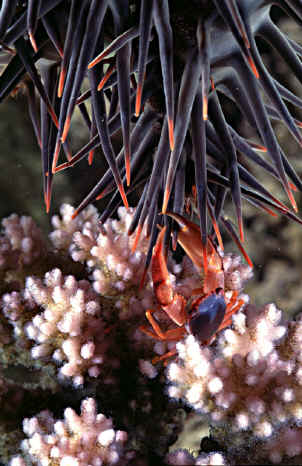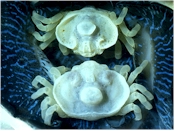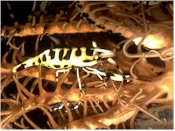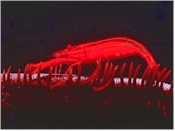Trapezius
This article is written by Andy Lewis
of Tevene'i Marine based
in Australia. Tevene'i Marine is a Coral Reef Ecology Consultancy
and Ecotourism business established by Dr. Andrew Lewis and Daniela
Lewis, graduates of the Department of Marine Biology at James Cook
University.

This shot shows a commensal crab (Trapezia
cymodoce) coming out of its host coral (Pocillopora damicornis)
to attack the arm of an invading Crown of Thorns Starfish (Acanthaster
planci).
Images from this attack sequence were recorded in digital
video and stereo 35mm still format on a combined IQ3D & Tevene'i Marine
Consultancy for the BBC at Lizard Island in late 1998. This and other
unique footage from that shoot will be seen in the BBC documentary "Blue
Planet", to be screened in 2001.
Biological Background
One of the special characteristics of coral reefs ecosystems
is their enormous biological diversity. Many other ecosystems also contain
vast numbers of species, however the diversity on coral reefs is still
apparent even at very small spatial scales. For example, the research
of Tevene'i Marine proprietor Dr. Andy Lewis showed that small coral "patch
reefs" about 200m2 (about the size of your living room) were consistently
home to more than 1000 fishes from more than 70 species! Drawing a terrestrial
parallel, you would need to search many hectares of tropical rainforest
to find a similar number of small bird or mammal species. (You can download
copies of Andy's scientific papers about the population dynamics of reef
fishes from his curriculum vitae page).
One of the fascinating consequences of all these organisms
living in such close proximity is the repeated evolution of symbiotic
relationships. These are relationships between two different species,
where both gain some advantage from the interaction. (Commensal relationships
are variants where the benefit goes mainly to one member of the pair).
Clown fish & anemones, and hard corals and algal zooxanthellae, are
two of the most touted examples of coral reef symbioses, but there are
literally hundreds of other relationships involving a wide range of different
taxa, and most of these have scarcely been studied by scientists.
The Crustacea (especially shrimps & crabs) in particular
have evolved many symbiotic and commensal species, which can be found
living on, in, or with other reef animals from giant clams, to anemones,
to starfish, to corals, to sponges. The dedicated photographic work of
Roger Steene has done much to enhance our appreciation of many of these
tiny but beautiful and fascinating animals.



The new "Image of the Month" highlights the mutualistic relationship
between hard corals and their crustacean symbionts. Many species of hard
corals grow as tightly clumped "bushes", and not surprisingly,
corals with this growth morphology provide ideal shelter sites for crustaceans
such as shrimps and crabs, and even small fishes such as gobies. These
relationships have evolved to the point that many of the infaunal species
are now only found within certain species of coral. Individuals feed,
grow and reproduce within a few bushes of coral, hardly ever venturing
beyond the confines of the colony.
The crab Trapezia cymodoce shown in the "Image
of the Month" is one such infaunal symbiont. It is found throughout
the Indo-Pacific, but only resides within corals from the family Pocilloporidae,
which includes the common species Pocillopora damicornis (shown
in the image), Seriatopora hystrix, and Stylophora pistillata.
Like most other coral reef organisms, T.cymodoce has an obligate
period of larval development in the open ocean before recruiting back
to the reef. Post-larval crabs usually settle individually into small
bushes of coral, while larger corals usually house a heterosexual breeding
pair of adult crabs. Very large coral colonies may house more than one
pair. Crabs do occasionally move short distances between coral colonies,
but only at night so as to minimise the predation risk.
It is fairly clear that the crab benefits from living
inside the coral. It feeds on mucous secreted by the coral, and also actively
feeds on coral tissue, scratching and probing at the polyps with its sharp
walking legs. Obviously, the crab also obtains a great deal of protection
from predators by staying within the narrow spaces between the arms of
the coral colony.
But what are the benefits to the coral? If the crab is in fact eating
coral tissue, its actions could be more akin to a parasite than a symbiont!
Yet field studies show that corals with crabs grow faster and suffer lower
mortality than those without crabs. This gives a clue to the answer -
the crabs are active defenders of their home, reducing the damage to the
colony from corallivores such as butterflyfish and Crown of Thorns starfish
(COTS). As shown in the "Image of the month", when a COTS approaches
a Pocilloporid coral, the crabs immediately rush forth and nip the tube
feet and spines of the starfish with their chelae.
This defence is so effective that, if given a choice,
COTS will actively avoid feeding on Pocillopora damicornis in favour
of specimens of Acropora which have less aggressive crustacean
symbionts. Only when there is little alternative will the starfish resort
to feeding on P. damicornis colonies. Indeed, where P. damicornis
is abundant, it may form natural barriers to COTS and create predation
refuges for other species of corals, thereby helping to maintain coral
biodiversity on COTS affected reefs.
So, the crab Trapezia cymodoce living in the
coral Pocillopora damicornis is another good example of the many
symbiotic partnerships found on coral reefs, where both members of the
partnership gain some benefit from the relationship. As a final word,
just to give you some idea of the complexity and diversity of the reef
environment via the microcosm of coral symbionts, we know there are more
than 10 different species of crabs in the genus Trapezia, plus
another genus of crabs (Tetralia), plus a few species of Alpheid
shrimps, plus at least 6 species of goby, all of which live in symbiotic
relationships with hard corals! Indeed, a large colony of Pocillopora
damicornis usually has a whole micro-community of crabs, shrimps,
and gobies inside it!




